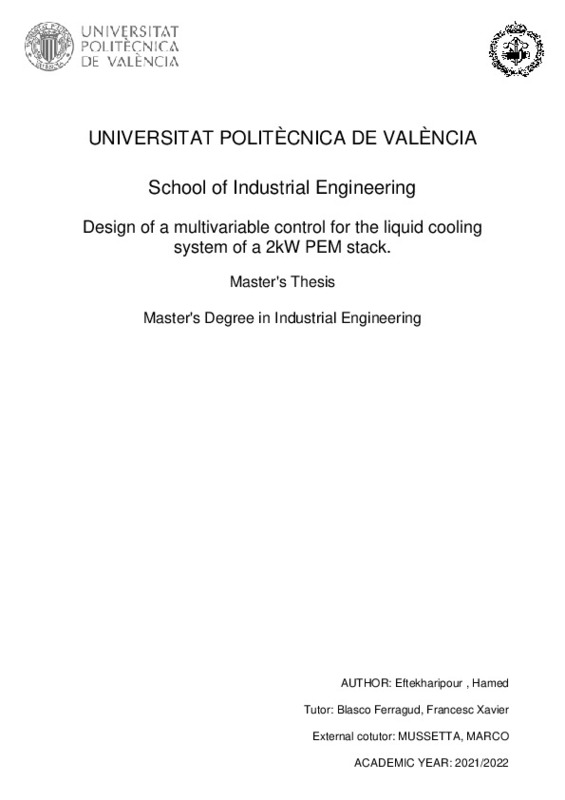JavaScript is disabled for your browser. Some features of this site may not work without it.
Buscar en RiuNet
Listar
Mi cuenta
Estadísticas
Ayuda RiuNet
Admin. UPV
Design of a multivariable control for the liquid cooling system of a 2kW PEM stack
Mostrar el registro sencillo del ítem
Ficheros en el ítem
| dc.contributor.advisor | Blasco Ferragud, Francesc Xavier
|
es_ES |
| dc.contributor.advisor | Mussetta, Marco
|
es_ES |
| dc.contributor.author | Eftekharipour, Hamed
|
es_ES |
| dc.date.accessioned | 2022-10-07T17:57:05Z | |
| dc.date.available | 2022-10-07T17:57:05Z | |
| dc.date.created | 2022-07-26 | |
| dc.date.issued | 2022-10-07 | es_ES |
| dc.identifier.uri | http://hdl.handle.net/10251/187270 | |
| dc.description.abstract | [ES] El objetivo principal de este trabajo es diseñar, ajustar y validar una estructura de control multivariable para el control de un proceso complejo. El proceso en cuestión es el control de temperatura de una pila tipo PEM que realiza la función de motor primario en un sistema micro-CHP (micro Combined Heat and Power). Es un sistema que debe suministrar energía eléctrica y térmica para aplicaciones domésticas. El control adecuado del subsistema térmico es fundamental para un funcionamiento óptimo. El trabajo tiene que proponer varias alternativas de control multivariable. Estas estructuras deben ajustarse de manera óptima para satisfacer dos objetivos simultáneamente: rendimiento y esfuerzo de control. El problema de sintonía se plantea como un problema de optimización multiobjetivo. En este caso particular, existe incertidumbre al trabajar con un modelo lineal cuando el proceso es no lineal. Hay una parte de la dinámica del proceso que no está correctamente modelada. Puede ocurrir una disminución significativa en el rendimiento cuando el controlador diseñado se aplica al proceso real. Luego, un paso adicional en la validación del controlador consiste en evaluar la robustez para las incertidumbres del modelo. Las tareas a realizar para lograr los objetivos propuestos son: Comprender el funcionamiento del sistema y obtener modelos lineales que representen adecuadamente el sistema al menos en un punto de funcionamiento. Comprender las herramientas de optimización multiobjetivo a utilizar para el planteamiento y resolución del problema de ajuste de las estructuras de control propuestas. Definir el problema de optimización multiobjetivo para el ajuste de controladores multivariables. Ajuste multiobjetivo de las diferentes estructuras de control multivariable a proponer. Análisis de resultados y evaluación de la robustez para validar la estructura propuesta en el proceso real. | es_ES |
| dc.description.abstract | [EN] The main objective of this work is to design, adjust and validate a multivariable control structure for the control of a complex process. The process concerned is the temperature control of a PEM type stack that performs the function of prime mover in a micro-CHP (micro Combined Heat and Power) system. It is a system that must supply electrical and thermal energy for domestic applications. Proper control of the thermal subsystem is essential for optimal operation. The work has to propose several alternatives for multivariable control. These structures must be optimally tuned to satisfy two objectives simultaneously: performance and control effort. The tuning problem is posed as a multiobjective optimization problem. In this particular case, there is uncertainty when working with a linear model when the process is non-linear. There is a part of the process dynamics that is not correctly modeled. A significant decrease in performance may occur when the designed controller is applied to the real process. Then an additional step in the controller validation consists of evaluating robustness for model uncertainties. The tasks to be performed in order to achieve the proposed objectives are: To understand the system's operation and to obtain linear models that adequately represent the system at least at one point of operation. To understand the multiobjective optimization tools to be used for the approach and resolution of the problem of adjustment of the proposed control structures. To define the multiobjective optimization problem for the tuning of multivariable controllers. Multiobjective adjustment of the different multivariable control structures to be proposed. Analysis of results and evaluation of the robustness for validating the proposed structure in the real process. | es_ES |
| dc.format.extent | 57 | es_ES |
| dc.language | Inglés | es_ES |
| dc.publisher | Universitat Politècnica de València | es_ES |
| dc.rights | Reserva de todos los derechos | es_ES |
| dc.subject | Control multivariable | es_ES |
| dc.subject | Optimización multiobjetivo | es_ES |
| dc.subject | Modelo lineal y no lineal | es_ES |
| dc.subject | Multivariable control | es_ES |
| dc.subject | Multiobjective optimization | es_ES |
| dc.subject | Linear and nonlinear model | es_ES |
| dc.subject.classification | INGENIERIA DE SISTEMAS Y AUTOMATICA | es_ES |
| dc.subject.other | Máster Universitario en Ingeniería Industrial-Màster Universitari en Enginyeria Industrial | es_ES |
| dc.title | Design of a multivariable control for the liquid cooling system of a 2kW PEM stack | es_ES |
| dc.title.alternative | Diseño de un control multivariable para el sistema de refrigeración líquido de una pila tipo PEM de 2kW. | es_ES |
| dc.title.alternative | Disseny d'un control multivariable per al sistema de refrigeració per líquid d'una pila PEM de 2kW. | es_ES |
| dc.type | Tesis de máster | es_ES |
| dc.rights.accessRights | Abierto | es_ES |
| dc.contributor.affiliation | Universitat Politècnica de València. Departamento de Ingeniería de Sistemas y Automática - Departament d'Enginyeria de Sistemes i Automàtica | es_ES |
| dc.contributor.affiliation | Universitat Politècnica de València. Escuela Técnica Superior de Ingenieros Industriales - Escola Tècnica Superior d'Enginyers Industrials | es_ES |
| dc.description.bibliographicCitation | Eftekharipour, H. (2022). Design of a multivariable control for the liquid cooling system of a 2kW PEM stack. Universitat Politècnica de València. http://hdl.handle.net/10251/187270 | es_ES |
| dc.description.accrualMethod | TFGM | es_ES |
| dc.relation.pasarela | TFGM\150088 | es_ES |
Este ítem aparece en la(s) siguiente(s) colección(ones)
-
ETSII - Trabajos académicos [10404]
Escuela Técnica Superior de Ingenieros Industriales






